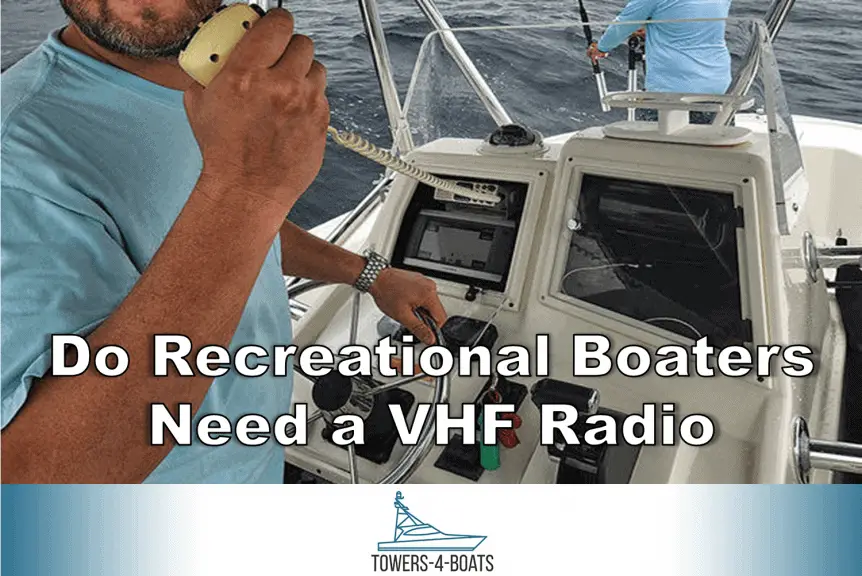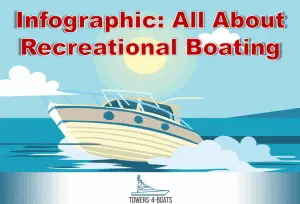Demystifying VHF Marine Radios Requirements
A VHF radio is perhaps one of the most important pieces of equipment you can have on your boat. These devices allow you to communicate with other vessels about navigation and safety information, which can quite literally save your life in the event of an emergency.
Recreational boats that are under 65 feet are not required to have a VHF radio. If you have a marine radio on your boat, you do not need a license to operate it. Although a radio is not legally required, you should have one for safety and convenience.
That being said, the rules and regulations around VHF marine radio use for recreational boaters in the United States are confusing, to say the least. So, it’s understandable if you’re not sure what you’re required to carry on your vessel. To help you get a better working knowledge of the regulations surrounding VHF marine radios, we put together this informative guide to recreational marine radio use for boaters. Let’s get started!
Want to know how to use your VHF radio? Check out my in-depth tutorial.
Is a VHF FM marine radio required on recreational boats?
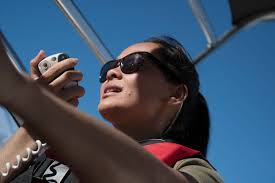 First things first, let’s answer this question once and for all: Are recreational boaters required to carry a VHF marine radio?
First things first, let’s answer this question once and for all: Are recreational boaters required to carry a VHF marine radio?
The answer? Well, if your boat is under 65 feet (20m) in length and used solely for recreational purposes, you’re in the clear. However, if your vessel is over 65 feet or used for commercial activity (even infrequently), you’re almost certainly required to have a VHF radio, so you’ll want to check out those regulations on your own.
Additionally, if you’re planning on making an international voyage, you’ll want to get a marine radio for your vessel. Other countries have vastly different regulations when compared to the U.S., so you don’t want to be caught without the proper equipment when you come into port in a different part of the world.
Does this mean you should forget your plans to buy that new VHF radio? Not at all. In fact, regardless of the size and shape of your boat, we highly recommend that you carry a marine radio at all times when on the water, even if it’s only a small handheld model.
VHF radios can and do save lives at sea every single day. With a marine radio, you can quickly and easily make a distress call, call into a harbormaster to inquire about coming alongside, or just talk with other vessels in the area to get an update on fishing conditions. Plus, most countries have repeated weather broadcasts over the marine radio system, so having a VHF radio can help you stay up to date on the weather.
So, no, you’re not required to have a VHF marine radio if you have a pleasure craft under 65 feet in length in the United States, but you probably should anyway – if you know how to use one.
Do I need a license for a VHF radio?
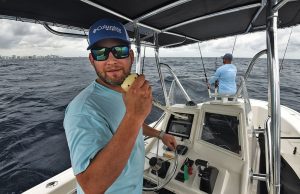 Now that you understand the need for a VHF marine radio, let’s talk a bit about licensing laws. It turns out that in the United States, marine radio use is regulated by the Federal Communications Commission (FCC) but that you, as a recreational operator of a pleasure craft under 65 feet, do not need to be individually licensed to use your marine radio.
Now that you understand the need for a VHF marine radio, let’s talk a bit about licensing laws. It turns out that in the United States, marine radio use is regulated by the Federal Communications Commission (FCC) but that you, as a recreational operator of a pleasure craft under 65 feet, do not need to be individually licensed to use your marine radio.
It is important to note that licensing requirements are very different in other countries, with some, like the United Kingdom, requiring all marine radio users to have a VHF license on U.K. flag state vessels. Thus, if you plan to travel internationally, you should check those regulations before departing.
But, even if you’re not licensed, you still need to follow all of the FCC’s rules regarding radio operations. For the most part, for recreational vessels under 65 feet in length, this means:
- Using the appropriate channel for your type of message (more on that later)
- Always identifying your radio transmissions with your vessel name and/or registration number
- Maintaining an adequate radio listening watch at all times on Channel 16
What does maintaining an adequate radio listening watch mean? Basically, it means that you keep your radio tuned into the appropriate channel when you’re not using it for communication.
The International Distress, Safety, and Calling channel, Channel 16 (156.800 MHz) is your go-to channel to stay on when you’re not actively communicating with other vessels. This channel is monitored by vessels and coast guards all over the world, so it’s your best choice for getting help in an emergency.
In the U.S., however, the FCC has also designated Channel 9 (156.450 MHz) as the Boater Calling channel as a secondary channel to relieve congestion on Channel 16, so this is another good wavelength to monitor. However, if you need help, communicate through Channel 16. Although the Coast Guard does its best to monitor all channels, they pay the most attention to Channel 16.
What Can I use my Marine VHF Radio For?
As you can imagine, there are a lot of rules and regulations that cover the use of your VHF-FM radio. It is important that you familiarize yourself with those requirements.
Use #1 – Emergency Assistance
The most important use of your marine radio is to send an SOS distress call. This is the Mayday! Mayday! Mayday! distress call you hear boaters make in movies. To make a call for help, follow these basic steps:
- Switch to channel 16
- Say “MAYDAY” three times
- Name of vessel in distress (say three times)
- Call sign or boat registration number
Use #2 – Calling Another Boat
If you need to contact a recreational boat, use channel 9. You should monitor this channel on your radio because this is how someone on shore or another boat will first try to contact you.
If you’re trying to contact a commercial ship, use Channel 16.
Use #3 – Contacting the Coast Guard
Recreational boaters can the US Coast Guard on channel 16. This might be to request assistance (emergency and non-emergency) or to report another vessel that needs help. Remember, channel 16 is for official use only. Do not make personal calls on this channel. The Coast Guard monitors it and they take any abuse very seriously.
What VHF channels can boaters use?
If you choose to carry a VHF marine radio (which we recommend), it is your duty to know what channels you’re authorized to use and for what purposes. Here’s your quick guide to VHF marine radio channels:
| Channel | Type of Message / Use |
| 06 | Inter-ship Safety. This channel is for ship-to-ship safety communications as well as search messages for USCG ship and aircraft |
| 09 | Boater Calling. This channel is designated by the FCC as a secondary calling channel for recreational boaters. It is designed to reduce congestion on VHF Channel 16 and should be monitored by all recreational boaters in addition to Channel 16. |
| 13, 67 | Navigation Safety/Bridge-to-Bridge. This channel is designed for use by ships greater than 65 feet (20m) in length as a channel for a listening watch in U.S. waters. Messages on this channel are about ship navigation and must be kept short. Power output on this channel may not be more than one watt. Many locks and drawbridges also use this as their working channel. Channel 67 is only designated as such on the lower Mississippi River. |
| 16 | International Distress, Safety, and Calling. This is the channel you should use when you’re trying to get the attention of others in an emergency. If you are carrying a radio, you must maintain an adequate listening watching at all times on this channel. The U.S. Coast Guard monitors this channel at all times. |
| 21A, 23A, 83A | U.S. Coast Guard Liaison and Maritime Safety Information Broadcast. The U.S. Coast Guard uses this channel to inform vessels of urgent maritime information broadcasts and storm warnings. |
| 22A | Public Correspondence (Marine Operator). These channels can be used to call a marine operator at a public station so you can make and receive calls from shore-based telephones. Unless this is a distress call, you usually have to pay for this service. |
| 24, 25, 26, 27, 28, 84, 85, 86 | Public Correspondence (Marine Operator). These channels can be used to call a marine operator at a public station so you can make and receive calls from shore-based telephones. Unless this is a distress call, you usually have to pay for this service. |
| 70 | Digital Selective Calling. This channel is reserved for distress and safety calling using digital selective calling (DSC) techniques only. |
So, with the exception of the U.S. Coast Guard only channels, you can use any of the above channels for their designated purpose. Other than that, you can use pretty much any other channel for personal chatter.
Most of the time, if you need to contact another vessel, you’ll do so over Channels 16 or 9 and ask to switch to another channel, such as Channel 69 to relieve congestion on these commonly used frequencies. Just keep in mind that these are not private channels. This means (1) other vessels may want to use that frequency, and (2) everyone can hear what you’re saying. So, keep your transmissions short and PG at all times.
How far can a marine radio transmit? / How far can I go offshore with my VHF radio?
At this point, you probably understand why marine radios are so important in the maritime world. However, a marine radio is only useful when it works and can make a connection with another ship or station.
So, you may be wondering how far a marine radio can transmit. The answer? It all depends on the height of your antenna. Since marine radios work on a line-of-sight basis, their ability to function depends on another antenna being within an unobstructed straight line shot of its own antenna.
Since the Earth is round, the main obstruction to a marine radio is the horizon line. However, this means that a taller antenna can reach much farther than a shorter one. How far? Well, if you’re standing at the helm of most recreational boats, the distance to the horizon for your standard adult is about three miles.
On the other hand, if you have an eight-foot antenna (for a total of 12 feet above sea level), your horizon line is about 4.5 miles away. But your horizon line isn’t the only thing that affects your ability to communicate with another ship – their antenna is important, too.
So, if your eight-foot antenna gets you 4.5 miles of horizon line and you’re connected to the Coast guard’s 100-foot tall antenna, you can get a communicable range of about 13 miles. Not too shabby.
In fact, our estimated distances usually fall a little short of the actual communicable distance of your antenna, thanks to atmospheric refraction, but we wouldn’t hinge your bets on those physics. Indeed, if you’re planning on going more than a few miles offshore into open waters, it’s highly recommended that you check out the U.S. Coast Guard’s VHF radio coverage in your area here.
Additionally, even if you plan to stay within the Coast Guard’s range, if you’re going more than a few miles offshore, you should really consider carrying a satellite phone, EPIRB (emergency position indicating radio beacon), and/or a PLB (personal locator beacon) in open waters. These devices are able to send distress signals even when you are far outside of radio contact with other ships or stations, meaning they could be your only hope for help.
How far does a handheld VHF reach?
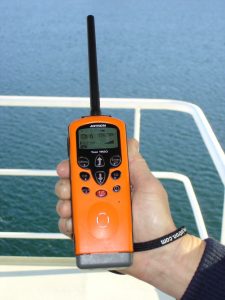 Since a VHF radio’s range is directly correlated with the height of its antennae, you might be wondering precisely how far your handheld VHF radio can reach. As you can imagine, a handheld radio’s range is going to be quite a bit shorter than that of a 12-foot antenna mounted on the top deck of a 400-foot ship. But, just how far can your handheld reach?
Since a VHF radio’s range is directly correlated with the height of its antennae, you might be wondering precisely how far your handheld VHF radio can reach. As you can imagine, a handheld radio’s range is going to be quite a bit shorter than that of a 12-foot antenna mounted on the top deck of a 400-foot ship. But, just how far can your handheld reach?
There are actually two factors at play when comparing a handheld VHF radio’s range to that of a fixed-mount unit. First and foremost, handheld VHF radios have a limited transmit power of just 6 watts, while a fixed-mount radio can transmit up to 25 watts. That being said, most radio manufacturers estimate that an increase from one to three watts of output power can give you about 10% more range but will drain your battery much more quickly.
Check Pricing on Amazon
Thus, antenna height is a much more accurate measure of how far your VHF radio can transmit. Based on the average 6” height of most handheld VHF radio antennas, you’re looking at about a mile and a half of range while standing on the deck of most pleasure craft. If you end up in the water, however, your range is pitifully small.
That doesn’t mean a handheld VHF is useless, though. In fact, if you go overboard and you’re the only person on your boat, having a VHF radio readily accessible may be your only means of attracting attention. We just wouldn’t rely on a handheld for all of our maritime communication needs.
Our advice? Get a fixed-mount radio for your vessel with as high an antenna as is feasible for your boat. Mount your antenna so it is oriented vertically from your boat with no obstructions – not in the cool raked-back orientation that gives you significantly less range.
Then, get yourself a handheld that you can keep on you at all times, especially when you’re alone, just in case. If you’re heading out into open water that’s more than a few miles offshore, you’ll also want to outfit your boat with an EPIRB or PLB, for when you’re not able to make contact with other vessels.
If you ever need help in an emergency, a VHF marine radio is your best bet for getting help. Although you’re not required to have one on your vessel as a recreational boater, if you ever need to make a distress call, you’ll be happy you invested in a VHF marine radio.

